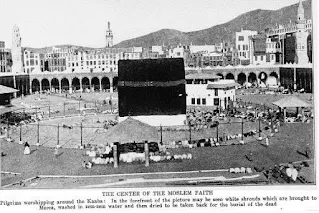The influence of animism on Islam
Excerpt from the introduction:
From the standpoint bottle of religion and culture Animism has been described as " the tap-root which sinks deepest in racial human experience and continues its cellular and fibrous structure in the tree-trunk of modem conviction."
All the great world religions show traces of animism in their sub-soil and none but Christianity (even that not completely) has uprooted the weed-growth of superstition. In this book, it is our purpose to show how Islam sprang up in Pagan soil and retained many old Arabian beliefs in spite of its vigorous monotheism. Wherever Mohammedanism went it introduced old or adopted new superstitions.
The result has been that as the background of the whole ritual and even in the creed of popular Islam, Animism has conquered. The religion of the common people from Tangier to Teheran is mixed with hundreds of superstitions many of which have lost their original significance but still bind mind and heart with the constant fear of demons, with witchcraft and sorcery and the call to creature-worship. Just as popular Hinduism differs in toto from the religion of the Vedas, popular Islam is altogether different from the religion as recorded in its sacred Book.
Our purpose in the chapters which follow is to show how this miry clay of animism mingles with the iron of Semitic theism in the feet of the great image with a head of gold that rests on Asia and Africa. The rapid spread of Islam in Africa and Malaysia is, we believe, largely due to its animistic character. The primitive religions had points of contact with Islam that were mutually attractive.
It stooped to conquer them but fell in stooping. The reformation of Islam, if such be possible, must begin here. The student of Islam will never understand the common people unless he knows their curious beliefs and half-heathen practices. The missionary should not only know but sympathize. Avoiding contempt or denunciation he will even find points of contact in Animistic Islam that may lead discussion straight to the Cross and the Atonement. In popular Islam, we have to deal with men and women groping after light and struggling in the mire for a firm foothold on the Rock.
This book may help us to find our hand in the dark. As we read its pages we must not forget that even in Egypt and India over ninety- four per credit of the Moslem population is illiterate and therefore has no other religion than popular Islam.
Content of the book:
I Islam and Animism 1-
II Animism in the Creed and the Use of the ROSAET 21
III Animistic Elements in Moslem Pratee . . .43'
IV Haie, Finger-Nails and the Hand .... 66
V The 'Aqiqa Sacrifice 87
V The 'Aqiqa Sacrifice 87
VI The Familiar Spirit or Qarina 107
VII Jinn 135
VIII Pagan Practices in Connection with the Pilgrimage 146
IX Magic and Sorcery 163
X Amulets, Charms and Knots 186
XI Tree, Stone, and Serpent Worship .... 208
XII The Zar: Exorcism of Demons 227
Samuel Marinus Zwemer, nicknamed The Apostle to Islam, was an American missionary, traveller, and scholar. He was born at Vriesland, Michigan. In 1887 he received an A.B. from Hope College, Holland, Mich., and in 1890, he received an M.A. from New Brunswick Theological Seminary, New Brunswick, N. J
Author: Samuel Zwemer
Publication Date: 1920
Download 9.5 MB

